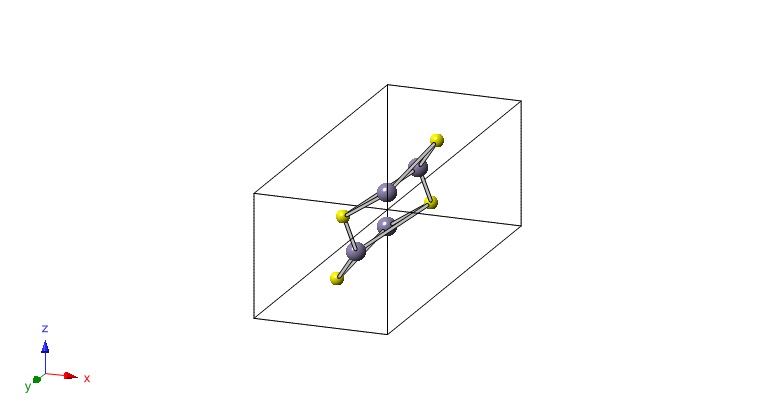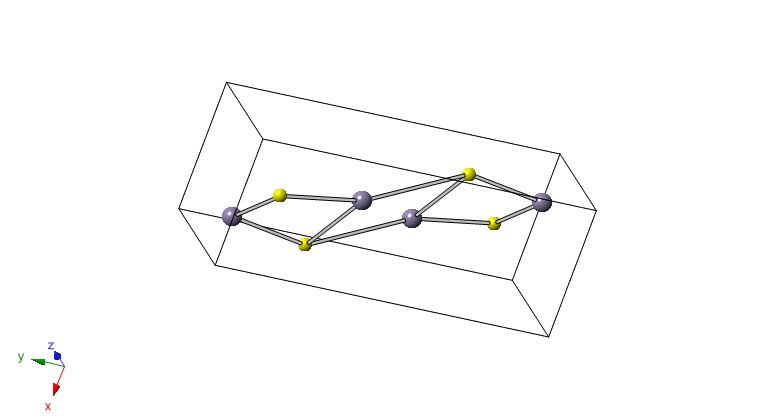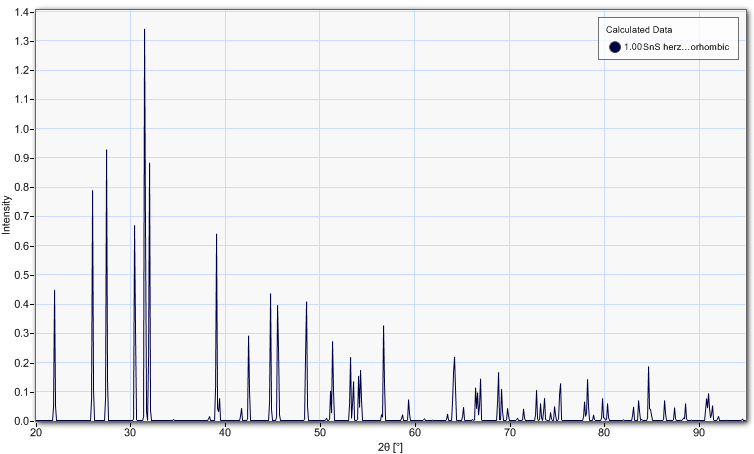Basic Info
Tin(II) Sulfide (SnS) is a brown solid and is insoluble in water. Its occurrence in nature takes the form a herzenbergite, which has an orthorhombic crystal structure. SnS also has hexoganol (wurtzite) and cubic (Sphalerite) crystal forms which are less stable than herzenbergite at room temperature.
Crystal Structure


| Fractional Coordinates | Orthogonal Coordinates | |||||||
|---|---|---|---|---|---|---|---|---|
| Label | Elmt | x | y | z | xor[Å] | yor[Å] | zor[Å] | |
| 1. | T2 | S | 0.4780 | 0.8500 | 0.2500 | 1.865 | -4.067 | 8.693 |
| 2. | T2 | S | 0.9780 | 0.6500 | 0.7500 | 4.885 | -3.169 | 6.764 |
| 3. | T2 | S | 0.5220 | 0.1500 | 0.7500 | 3.585 | -1.595 | 1.198 |
| 4. | T2 | S | 0.0220 | 0.3500 | 0.2500 | 0.565 | -2.493 | 3.127 |
| 5. | T1 | Sn | 0.1150 | 0.1180 | 0.2500 | 0.971 | -1.035 | 0.982 |
| 6. | T1 | Sn | 0.6150 | 0.3820 | 0.7500 | 3.795 | -2.608 | 3.610 |
| 7. | T1 | Sn | 0.8850 | 0.8820 | 0.7500 | 4.479 | -4.627 | 8.908 |
| 8. | T1 | Sn | 0.3850 | 0.6180 | 0.2500 | 1.655 | -3.053 | 6.281 |
The graph below shows peak intensities for SnS:

PV Applications
SnS is a p-type semiconducting material with a layered orthorhombic structure. It has little toxicity to humans and the environment as well as a band gap of 1.0-1.5 eV. This makes SnS a suitable option as the absorption layer in n-type solar cells with a wide band gap. Various techniques of fabricating SnS thin films include: vacuum evaporation, chemical bath deposition, and spray pyrolysis. 1
Basic Parameters at 300 K
| Crystal structure: | Orthorhombic | 2 |
| Group of symmetry: | Pbnm | 2 |
| Number of atoms in 1 cm3: | 4.15*1026 | 2 |
| Unit cell volume: | 192.6 Å3 | [6] |
| Atoms per unit cell: | 4 | [7] |
| Debye temperature: | 270 K | [12] |
| Density: | 5.08 g/cm3 | [12] |
| Dielectric constants: | ||
| ε(0) | 32(4) E||a T=300 K | [12] |
| 48(5) E||b | ||
| 32(4) E||c | ||
| ε(∞) | 14(2) E||a | |
| 16(2) E||b | ||
| 16(2) E||c | ||
| Effective electron density: | 6.3*1014-1.2*1015 cm-3 | Devika2006 |
| Effective hole density: | 1018 cm-3 | Devika2006 |
| Effective Masses: | ||
| Mp(||a) | 0.2 m0 T= 300 K | [12] |
| Mp(||b) | 0.2 m0 | |
| Mp(||c) | 1.0 m0 | |
| Mds,p | 0.95 m0 T = 300 K | [12] |
| Mds,p | 0.45 m0 |
| Lattice constants: | |
| a= 4.33 Å | |
| b = 11.18 Å | |
| c = 3.98 Å |
Band structure and carrier concentration
Band Structure and carrier concentration
Data on variation of optical bandgap of SnS films with thickness may be found in Thickness Effect on the Physical Properties of Evaporated SnS Films M. Devika, N. Koteeswara Reddy, K. Ramesh, R. Ganesan, K. R. Gunasekhar, E. S. R. Gopal, and K. T. Ramakrishna Reddy, J. Electrochem. Soc. 154, H67 (2007), DOI:10.1149/1.2398816 [10]
Temperature Dependence
Graphs of conductivity and Grain size vs. temperature of SnS may be found in M. Devika, K. T. Ramakrishna Reddy, N. Koteeswara Reddy, K. Ramesh, R Ganesan et al., Microstructure dependent physical properties of evaporated tin sulfide films, J. Appl. Phys. 100, 023518 (2006_; doi: 10.1063/1.2216790 3
Donors and Acceptor
Donors: Cl, Al
Acceptors: Cu, Ag
Donar and acceptor ionization energies [12]
| Compound | Impurity | Donor Ionization energy, eV | Acceptor Ionization energy, eV |
| ZnS | Cl | 0.25, 0.37 | |
| Cu | 0.95 | ||
| Ag | 0.55 |
Electrical Properties
Basic Parameters of Electrical Properties
Energy gap: Direct:1.2-1.5 eV 1
Indirect: 1.0-1.2 ev 1
Binding Energies: S 2p3/2 = 161.4 eV 3
Sn 3d5/2 = 485.3 eV 3
Intrinsic carrier concentration: 109 cm-3 (300 K) [8]
Hole mobility (Hall Mobility): 90 cm2/Vs (resistivity = 0.06 Ω cm @ 300 K) 3
Intrinsic resistivity: 13-20 Ω 3
Mobility and Hall Effect
Graph of hall mobility and carrier density as a function of substrate temperature may be found in N. Koteeswara Reddy, K.T. Ramakrishna Reddy, Electrical properties of spray pyrolytic tin sulfide films, Solid-State Electronics, Volume 49, Issue 6, June 2005, Pages 902-906, ISSN 0038-1101, 10.1016/j.sse.2005.03.003. [9]
Optical properties
Refractive index 3.52 3
Absorption coefficient 104 cm-1 3
Graph of Transmittance as a function of wavelength for SnS grown thin films can be found in Thickness Effect on the Physical Properties of Evaporated SnS Films M. Devika, N. Koteeswara Reddy, K. Ramesh, R. Ganesan, K. R. Gunasekhar, E. S. R. Gopal, and K. T. Ramakrishna Reddy, J. Electrochem. Soc. 154, H67 (2007), DOI:10.1149/1.2398816 [10]
Plots of absorption spectroscopy and absorption coefficient vs photon energy may be found in Wei Guang-Pu; Zhang Zhi-Lin; Zhao Wei-Ming; Gao Xiang-Hong; Chen Wei-Qun; Tanamura, H.; Yamaguchi, M.; Noguchi, H.; Nagatomo, T.; Omoto, O.; , "Investigation on SnS film by RF sputtering for photovoltaic application," Photovoltaic Energy Conversion, 1994., Conference Record of the Twenty Fourth. IEEE Photovoltaic Specialists Conference - 1994, 1994 IEEE First World Conference on , vol.1, no., pp.365-368 vol.1, 5-9 Dec 1994 doi: 10.1109/WCPEC.1994.519977 [5]
Thermal properties
Linear thermal expansion coefficient: α = 2.8*10-7 K-1 T= 300K [12]
Heat capacity: CP = 45 J mol-1 K-1 T=300 K [12]
CP = 29.3 J mol-1 K-1 T= 80 K [12]
Mechanical properties, elastic constants, lattice vibrations
Basic Parameters
Bulk modulus: 36.6 GPa [6]
Density: 5.08 g/cm3 [12]
Hardness: 2 on Mohs scale [7]
Phonon Frequencies
|
VTO(B1u) |
6.64*1012 s-1 | T = 300 K |
| VLO(B1u) | 8.28*1012 s-1 | |
| VTO(B1u) | 5.32*1012 s-1 | |
| VTO(B1u) | 6.43*1012 s-1 | |
| VTO(B1u) | 2.96*1012 s-1 | |
| VLO(B1u) | 3.2*1012 s-1 |
[12]
[2] Naoya Sato, Masaya Ichimura, Eisuke Arai, Yoshihisa Yamazaki, Characterization of electrical properties and photosensitivity of SnS thin films prepared by the electrochemical deposition method, Solar Energy Materials and Solar Cells, Volume 85, Issue 2, 15 January 2005, Pages 153-165, ISSN 0927-0248, 10.1016/j.solmat.2004.04.014.
(http://www.sciencedirect.com/science/article/pii/S0927024804002077)
[4] M. Calixto-Rodriguez, H. Martinez, A. Sanchez-Juarez, J. Campos-Alvarez, A. Tiburcio-Silver, M.E. Calixto, Structural, optical, and electrical properties of tin sulfide thin films grown by spray pyrolysis, Thin Solid Films, Volume 517, Issue 7, 2 February 2009, Pages 2497-2499, ISSN 0040-6090, 10.1016/j.tsf.2008.11.026.
(http://www.sciencedirect.com/science/article/pii/S0040609008014077)
[5] Wei Guang-Pu; Zhang Zhi-Lin; Zhao Wei-Ming; Gao Xiang-Hong; Chen Wei-Qun; Tanamura, H.; Yamaguchi, M.; Noguchi, H.; Nagatomo, T.; Omoto, O.; , "Investigation on SnS film by RF sputtering for photovoltaic application," Photovoltaic Energy Conversion, 1994., Conference Record of the Twenty Fourth. IEEE Photovoltaic Specialists Conference - 1994, 1994 IEEE First World Conference on , vol.1, no., pp.365-368 vol.1, 5-9 Dec 1994 doi: 10.1109/WCPEC.1994.519977
(http://ieeexplore.ieee.org/stamp/stamp.jsp?tp=&arnumber=519977&isnumber=11458)
[6] L ehm, K knorr, P dera, A krimmel, P bouvier, and M Meqouar, Pressure-induced structural phase transistion in the IV-VI semiconductor SnS, J. Phys.: Condens. Matter 16 3545 doi:10.1088/0953-8984/16/21/004
(http://iopscience.iop.org/0953-8984/16/21/004)
[7] Wolframalpha, Herzenbergite: fomula, density, Mohs hardness, refractive index,…
(http://preview.wolframalpha.com/entities/minerals/herzenbergite/ii/w2/73/)
[8] Polymorphic Tin Sulfide Thin Films of Zinc Blende and Orthorhombic Structures by Chemical Deposition David Avellaneda, M. T. S. Nair, and P. K. Nair, J. Electrochem. Soc. 155, D517 (2008), DOI:10.1149/1.2917198
(http://scitation.aip.org/getpdf/servlet/GetPDFServlet?filetype=pdf&id=JE...)
[9] N. Koteeswara Reddy, K.T. Ramakrishna Reddy, Electrical properties of spray pyrolytic tin sulfide films, Solid-State Electronics, Volume 49, Issue 6, June 2005, Pages 902-906, ISSN 0038-1101, 10.1016/j.sse.2005.03.003.
(http://www.sciencedirect.com/science/article/pii/S0038110105000845)
[10] Thickness Effect on the Physical Properties of Evaporated SnS Films
M. Devika, N. Koteeswara Reddy, K. Ramesh, R. Ganesan, K. R. Gunasekhar, E. S. R. Gopal, and K. T. Ramakrishna Reddy, J. Electrochem. Soc. 154, H67 (2007), DOI:10.1149/1.2398816
(http://scitation.aip.org/getabs/servlet/GetabsServlet?prog=normal&id=JES...)
[11] Richard H. Bube and Edward L. Lind, Photoconductivity of Zinc selenide crystals and a correlation of donor and acceptor levels in II-VI photoconductors. DOI: 10.1103/PhysRev.110.1040 (http://prola.aps.org/abstract/PR/v110/i5/p1040_1)
[12] Madelung, O. (2004). Semiconductors: Data handbook. (3rd ed., pp. 1981-1989). Springer.
Developed at the University of Utah primarily by undergraduate students Jeff Provost and Carina Hahn working with Prof. Mike Scarpulla. Caitlin Arndt, Christian Robert, Katie Furse, Jash Sayani, and Liz Lund also contributed. The work was fully supported by the US National Science Foundation under the Materials World Network program award 1008302. These pages are a work in progress and we solicit input from knowledgeable parties around the world for more accurate or additional information. Contact [email protected] with such suggestions.
- 1. a. b. c. «Characterization of electrical properties and photosensitivity of SnS thin films prepared by the electrochemical deposition method», Solar Energy Materials and Solar Cells, vol. 85, n.º 2, pp. 153 - 165, 2005.
- 2. a. b. c. Crystal Structures 1, 2nd.ª ed., vol. 1. New York, New York: Interscience Publishers, 1963.
- 3. a. b. c. d. e. f. g. «Microstructure dependent physical properties of evaporated tin sulfide films», Journal of Applied Physics, vol. 100, n.º 2, p. 023518, 2006.
